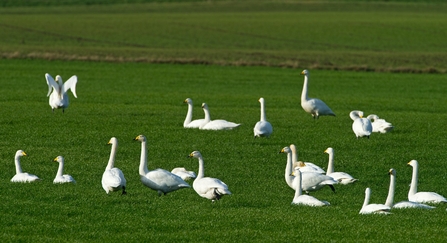As the weather gets colder, other species start to appear in the Great Fen. Bramblings, those exotic-looking relatives of the chaffinch, join us, often in flocks mixed with other birds. Whooper swans start to use our larger meres and the numbers of snipe and woodcock increase, in our grasslands and woodlands.
The ditches become a real sanctuary for many species, and our restoration work to increase the beds of reed around them, really makes a difference. Reed buntings soon set up a roost in the reedbeds, venturing out to feed as the morning warms up. Reedbeds can also be used as roosts by pied wagtails, wandering around the nearby cattle, in search of insects. The stonechats are also insectivorous and so also tend to be found along the ditches, which are a good source of insects, or other invertebrates.
Cattle and sheep are widespread on the Fen at the moment, as the grazing of the grasslands takes place, through to next March. It is worth checking out the temporary electric fenceposts and wires for stonechats, where they are in close proximity to a well-developed reed-fringed ditch.
A sunny, calm day is best to watch for stonechats, once it has warmed up a bit. They are often in pairs, or even more than one pair. They may sit on the wires and drop down into the grass in search of insects, or fly up to snatch the occasional one in flight.
Since we started the stonechat colour ring protect, we have ringed over 20 birds, and have already seen some of the birds again (re-sighted). Birds have been seen on the Last of the Meres trail, and the Northern Loop. These birds were ringed back in October or earlier, so it is good to see they are still around.
We have now had a few frosts, not many, so the Fen can look stunning in the morning, a great time to visit. As the Fen becomes more and more popular, it is worth considering the best time to visit, and where to park. The Great Fen Information Point at New Decoy, has plenty of parking, and is the trail head for walks both short and long, providing access to the northern part of the Great Fen, including Holme Fen.
Stonechats have been seen recently, along the circular walk of the Dragonfly Trail, which starts at New Decoy. It can take one to two hours to complete, depending how often you stop to take in the view. Sightings of a variety woodland birds can be seen, in Railway Covert, and flyovers of buzzard, red kite even raven are also possible; so look up from time to time! As the winter progresses, short-eared owl is also a favourite for photographers here, and as numbers are starting to increase now, New Decoy is worth checking out in the early evening, just before what can be, a stunning sunset.
For more tips on planning your visit to the Great Fen, check out the blogs by the Fenland Coddiwomple, or for tips on a photographic visit, check out my recent talk, as part of Cambridge photography Week.

